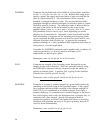
Type PEC
Type black
Perfect conductor. All fields inside a PEC are zero.
Sometimes useful for saving CPU cycles in regions where the
fields are known to be zero, e.g. deep inside metal objects.
Parameters: none
3.1.5. OBJECT Group
Like all dimensions in POEMS, object dimensions are measured from edge to edge, as you
would measure with calipers. All dimensions are correctly rounded to the nearest
multiple of basicstep in the subdomain in which they occur. A cell is included if its centre
lies inside the specified region. This can lead to steps at boundaries between
subdomains with different basicstep values, due to differences in rounding.
When an object’s midline is specified in terms of a curve, e.g. FAN, GRATING, CURVE,
and 3DCURVE, the end points of the curve are taken to lie at the centre of the outermost
plane of blocks on each end. This makes sure that if the local object axis is highly
inclined, the outermost blocks don’t disappear due to their centres falling outside the
region, as they would if the endpoint were taken to lie in the outer face. Sufficiently
inclined objects may still become discontinuous.
BLOCK Adds a rectangular prism (like a shoe box) of material matname,
covering the region xlo ≤ x ≤ xhi, ylo ≤ y ≤ yhi, zlo ≤ z ≤ zhi. Like
everything else in POEMS, these dimensions will be rounded to the
nearest cell boundaries.
Parameters: matname xlo xhi ylo yhi zlo zhi
Example:
block matname = AirPML xlo=0 xhi=8*dx ylo = 0 yhi=ymax ,
zlo=0 zhi=zmax
FAN Adds a fan shaped object such as a dielectric waveguide horn or
taper. A fan is specified by a choice of curve and rectangular end
faces 1 and 2, defined by their diagonal points ((xlo1,ylo1,zlo1),
(xhi1,yhi1,zhi1)) and ((xlo2,ylo2,zlo2), (xhi2,yhi2,zhi2)). These must be
parallel and lie in a coordinate plane. Intervening planes are
defined by the choice of taper and the taper parameter, which is a
scale factor for the domain of the curve—increasing the parameter
causes the taper to be sharper, and decreasing it makes the taper
more gradual. Allowed tapers are LINEAR, EXPONENTIAL, and
ERF. Exponential tapers are useful for converting guided waves to
free space, and ERF tapers are useful for converting between
different-sized waveguides without strong back reflections from
either end.
18


















